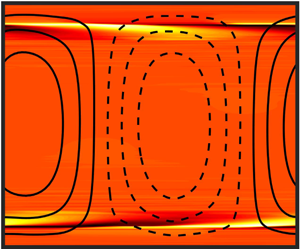Crossref Citations
This article has been cited by the following publications. This list is generated based on data provided by
Crossref.
Song, Jiaxing
Wan, Zhen-Hua
Liu, Nansheng
Lu, Xi-Yun
and
Khomami, Bamin
2021.
A reverse transition route from inertial to elasticity-dominated turbulence in viscoelastic Taylor–Couette flow.
Journal of Fluid Mechanics,
Vol. 927,
Issue. ,
Khalid, Mohammad
Shankar, V.
and
Subramanian, Ganesh
2021.
Continuous Pathway between the Elasto-Inertial and Elastic Turbulent States in Viscoelastic Channel Flow.
Physical Review Letters,
Vol. 127,
Issue. 13,
Wan, Dongdong
Sun, Guangrui
and
Zhang, Mengqi
2021.
Subcritical and supercritical bifurcations in axisymmetric viscoelastic pipe flows.
Journal of Fluid Mechanics,
Vol. 929,
Issue. ,
Song, Jiaxing
Lin, Fenghui
Liu, Nansheng
Lu, Xi-Yun
and
Khomami, Bamin
2021.
Direct numerical simulation of inertio-elastic turbulent Taylor–Couette flow.
Journal of Fluid Mechanics,
Vol. 926,
Issue. ,
Yamani, Sami
Keshavarz, Bavand
Raj, Yashasvi
Zaki, Tamer A.
McKinley, Gareth H.
and
Bischofberger, Irmgard
2021.
Spectral Universality of Elastoinertial Turbulence.
Physical Review Letters,
Vol. 127,
Issue. 7,
Shaqfeh, Eric S.G.
and
Khomami, Bamin
2021.
The Oldroyd-B fluid in elastic instabilities, turbulence and particle suspensions.
Journal of Non-Newtonian Fluid Mechanics,
Vol. 298,
Issue. ,
p.
104672.
Hariharan, Gokul
Jovanović, Mihailo R.
and
Kumar, Satish
2021.
Localized stress amplification in inertialess channel flows of viscoelastic fluids.
Journal of Non-Newtonian Fluid Mechanics,
Vol. 291,
Issue. ,
p.
104514.
Shekar, Ashwin
McMullen, Ryan M.
McKeon, Beverley J.
and
Graham, Michael D.
2021.
Tollmien-Schlichting route to elastoinertial turbulence in channel flow.
Physical Review Fluids,
Vol. 6,
Issue. 9,
Zhang, Mengqi
2021.
Energy growth in subcritical viscoelastic pipe flows.
Journal of Non-Newtonian Fluid Mechanics,
Vol. 294,
Issue. ,
p.
104581.
Khalid, Mohammad
Chaudhary, Indresh
Garg, Piyush
Shankar, V.
and
Subramanian, Ganesh
2021.
The centre-mode instability of viscoelastic plane Poiseuille flow.
Journal of Fluid Mechanics,
Vol. 915,
Issue. ,
Boaro, Alessio
and
Lappa, Marcello
2022.
On the competition of transverse and longitudinal modes of Marangoni convection in a three-dimensional layer of viscoelastic fluid.
Physics of Fluids,
Vol. 34,
Issue. 12,
Castillo Sánchez, Hugo A.
Jovanović, Mihailo R.
Kumar, Satish
Morozov, Alexander
Shankar, V.
Subramanian, Ganesh
and
Wilson, Helen J.
2022.
Understanding viscoelastic flow instabilities: Oldroyd-B and beyond.
Journal of Non-Newtonian Fluid Mechanics,
Vol. 302,
Issue. ,
p.
104742.
Morozov, Alexander
2022.
Coherent Structures in Plane Channel Flow of Dilute Polymer Solutions with Vanishing Inertia.
Physical Review Letters,
Vol. 129,
Issue. 1,
Buza, Gergely
Page, Jacob
and
Kerswell, Rich R.
2022.
Weakly nonlinear analysis of the viscoelastic instability in channel flow for finite and vanishing Reynolds numbers.
Journal of Fluid Mechanics,
Vol. 940,
Issue. ,
Buza, Gergely
Beneitez, Miguel
Page, Jacob
and
Kerswell, Rich R.
2022.
Finite-amplitude elastic waves in viscoelastic channel flow from large to zero Reynolds number.
Journal of Fluid Mechanics,
Vol. 951,
Issue. ,
Datta, Sujit S.
Ardekani, Arezoo M.
Arratia, Paulo E.
Beris, Antony N.
Bischofberger, Irmgard
McKinley, Gareth H.
Eggers, Jens G.
López-Aguilar, J. Esteban
Fielding, Suzanne M.
Frishman, Anna
Graham, Michael D.
Guasto, Jeffrey S.
Haward, Simon J.
Shen, Amy Q.
Hormozi, Sarah
Morozov, Alexander
Poole, Robert J.
Shankar, V.
Shaqfeh, Eric S. G.
Stark, Holger
Steinberg, Victor
Subramanian, Ganesh
and
Stone, Howard A.
2022.
Perspectives on viscoelastic flow instabilities and elastic turbulence.
Physical Review Fluids,
Vol. 7,
Issue. 8,
Nimura, Tomohiro
and
Tsukahara, Takahiro
2022.
Viscoelasticity-Induced Instability in Plane Couette Flow at Very Low Reynolds Number.
Fluids,
Vol. 7,
Issue. 7,
p.
241.
Page, Jacob
and
Zaki, Tamer A.
2022.
Vorticity amplification in wavy viscoelastic channel flow.
Journal of Fluid Mechanics,
Vol. 949,
Issue. ,
Zhang, Wen-Hua
Zhang, Hong-Na
Wang, Zi-Mu
Li, Yu-Ke
Yu, Bo
and
Li, Feng-Chen
2022.
Repicturing viscoelastic drag-reducing turbulence by introducing dynamics of elasto-inertial turbulence.
Journal of Fluid Mechanics,
Vol. 940,
Issue. ,
Dzanic, V.
From, C. S.
and
Sauret, E.
2022.
Conserving elastic turbulence numerically using artificial diffusivity.
Physical Review E,
Vol. 106,
Issue. 1,

 $Re=3000$ reveal the existence of a family of attractors whose structure closely resembles the linear Tollmien–Schlichting (TS) mode, and in particular exhibits strongly localized stress fluctuations at the critical layer position of the TS mode. At the parameter values chosen, this solution branch is not connected to the nonlinear TS solution branch found for Newtonian flow, and thus represents a solution family that is nonlinearly self-sustained by viscoelasticity. The ratio between stress and velocity fluctuations is in quantitative agreement for the attractor and the linear TS mode, and increases strongly with Weissenberg number,
$Re=3000$ reveal the existence of a family of attractors whose structure closely resembles the linear Tollmien–Schlichting (TS) mode, and in particular exhibits strongly localized stress fluctuations at the critical layer position of the TS mode. At the parameter values chosen, this solution branch is not connected to the nonlinear TS solution branch found for Newtonian flow, and thus represents a solution family that is nonlinearly self-sustained by viscoelasticity. The ratio between stress and velocity fluctuations is in quantitative agreement for the attractor and the linear TS mode, and increases strongly with Weissenberg number,  $\mathit{Wi}$. For the latter, there is a transition in the scaling of this ratio as
$\mathit{Wi}$. For the latter, there is a transition in the scaling of this ratio as  $\mathit{Wi}$ increases, and the
$\mathit{Wi}$ increases, and the  $\mathit{Wi}$ at which the nonlinear solution family comes into existence is just above this transition. Finally, evidence indicates that this branch is connected through an unstable solution branch to two-dimensional elastoinertial turbulence (EIT). These results suggest that, in the parameter range considered here, the bypass transition leading to EIT is mediated by nonlinear amplification and self-sustenance of perturbations that excite the TS mode.
$\mathit{Wi}$ at which the nonlinear solution family comes into existence is just above this transition. Finally, evidence indicates that this branch is connected through an unstable solution branch to two-dimensional elastoinertial turbulence (EIT). These results suggest that, in the parameter range considered here, the bypass transition leading to EIT is mediated by nonlinear amplification and self-sustenance of perturbations that excite the TS mode.



